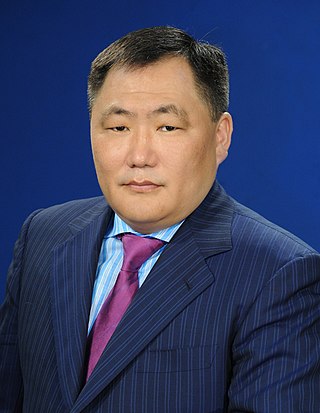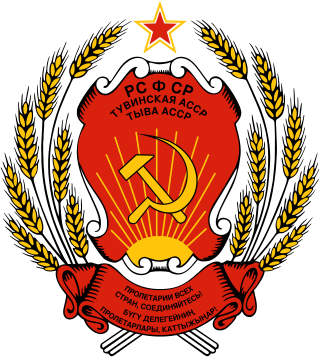
The Tuvan People's Republic or TPR; known as the Tannu Tuva People's Republic until 1926, was a partially recognized state that existed between 1921 and 1944. It was formally a socialist republic and de facto a Soviet puppet state. The TPR was located in Tuva, covering the same territory, north-west of Mongolia, as was the previous 1914–1921 Tuvan protectorate of the former Russian Empire, and is now the Tuva Republic, an administrative part of Russia.

The Tuvans or Tyvans are a Turkic ethnic group indigenous to Siberia who live in Russia (Tuva), Mongolia, and China. They speak Tuvan, a Siberian Turkic language. In Mongolia they are regarded as one of the Uriankhai people groups.

Kyzyl is the capital city of the republic of Tuva, Russia. The name of the city means "red" or "crimson" in Tuvan. Its population was 120,067 (2021 Census);

Genghis Blues is a 1999 American documentary film directed by Roko Belic. It centers on the journey of blind American singer Paul Pena to the isolated Russian Republic of Tuva to pursue his interest in Tuvan throat singing.

Kongar-ool Borisovich Ondar was a master Soviet and Russian Tuvan throat singer and a member of the Great Khural of Tuva.
Tuva is a part of Russia, inhabited by a Turkic people. Tuvans are known abroad for khoomei (xöömej), a kind of overtone singing.

Sainkho Namtchylak is a singer originally from Tuva, an autonomous republic in the Russian Federation just north of Mongolia. She is known for her Tuvan throat singing or Khöömei.

Tuva or Tyva, officially the Republic of Tuva, is a republic of Russia. Tuva lies at the geographical center of Asia, in southern Siberia. The republic borders the Altai Republic, Khakassia, Krasnoyarsk Krai, Irkutsk Oblast, and Buryatia in Russia, and shares an international border with Mongolia to the south. Tuva has a population of 336,651. Its capital is the city of Kyzyl.

The Tuvan Autonomous Soviet Socialist Republic, or the Tuvan ASSR, was an autonomous republic of the Russian SFSR. It was created on 10 October 1961 from the Tuvan Autonomous Oblast. Its territory measured 175,000 square kilometers and bordered Mongolia to the south, Buryat ASSR to the east, Gorno-Altai Autonomous Oblast to the west and Khakas Autonomous Oblast to the north.

The Tuvan Autonomous Oblast was an autonomous oblast of the Soviet Union, created on 11 October 1944 following the annexation of the Tuvan People's Republic by the Soviet Union. On 10 October 1961, it was transformed into the Tuvan Autonomous Soviet Socialist Republic. On 31 March 1992, its successor, the Tuva Republic, became a constituent member of the Russian Federation.
Tooruktug Dolgai Tañdym is a Tuvan folk song. It was first adopted in 1944 as the national anthem of the Tuvan People's Republic (TPR) when Tuva was an independent socialist republic recognised only by the Soviet Union and the Mongolian People's Republic. Later in the same year following the Soviet annexation of Tuva, the country was then incorporated into the USSR and thus became the Tuvan Autonomous Oblast (TAO). In 1961, the political status of the region was upgraded to the Tuvan Autonomous Soviet Socialist Republic, yet the anthem still remained.

Salchak Kalbakkhorekovich Toka was a Tuvan and later, Soviet politician. He was General Secretary of the Tuvan department of the CPSU from 1944 to 1973; previously, he was the General Secretary of the Central Committee of the Tuvan People's Revolutionary Party and was the supreme ruler of the Tuvan People's Republic from 1932 until its annexation by the Soviet Union in 1944.

Mongol-Tuvan throat singing, the main technique of which is known as khoomei, is a style of singing practiced by people in Tuva and Mongolia. It is noted for including overtone singing. In 2009, it was included in the Representative List of the Intangible Cultural Heritage of Humanity of UNESCO. The term hömey / kömey means throat and larynx in different Turkic languages. That could be borrowed from Mongolian khooloi, which means throat as well, driven from Proto-Mongolian word *koɣul-aj.

The emblem of Tuva is a light blue field with a yellow border. In the center of the field is a traditional horseman, symbolizing Tuva's sovereignty and spirit. The coat of arms was created in 1992, and is similar to the present state emblem of Mongolia, which was adopted that same year.

The Tuvan People's Republic issued postage stamps between 1926 and 1936. They were popular with stamp collectors in the Western world in the mid-twentieth century because of the obscurity and exoticism of Tannu Tuva and the stamps' quirky, colorful designs. The validity of many stamps purportedly issued by Tannu Tuva has been questioned by philatelists.

Sholban Valeryevich Kara-ool is a Russian politician of Tuvan ethnic origins. He was the Head of the Republic of Tuva, a Russian republic.

The national emblem of the Tuvan Autonomous Soviet Socialist Republic was adopted in 1962 by the government of the Tuvan Autonomous Soviet Socialist Republic. The emblem is identical to the emblem of the Russian Soviet Federative Socialist Republic.

The Tuvan People’s Republic entered World War II on the side of the Allied Powers, shortly after the invasion of the Soviet Union by Nazi Germany that broke the non-aggression pact between the Soviet Union and Third Reich.

The Tuvan People's Revolutionary Army (TNRA) (Russian: Тувинская народно-революционная армия; Tuvan: Тываның Араттың Революстуг Шерии) was the military wing of the Tuvan People's Revolutionary Party which constituted the armed forces of the Tuvan People's Republic.
















